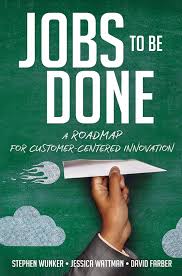In today’s digital age, a well-crafted website content strategy is essential for businesses to connect with their target audience and drive growth. This white paper explores a strategic approach to website content creation, focusing on customer pain points and the “Jobs to Be Done” framework, as popularized by Clayton Christensen. We will also delve into the concept of service and solution innovation, inspired by Peter Senge’s Fifth Discipline. By understanding and addressing customer needs, businesses can create compelling content that resonates and drives.
White Paper: A Job to Be Done Approach to Website & Ecommerce Content Strategy
Introduction
In today’s digital age, a well-crafted website content strategy is essential for businesses to connect with their target audience and drive growth. This white paper explores a strategic approach to website content creation, focusing on customer pain points and the “Jobs to Be Done” framework, as popularized by Clayton Christensen. We will also delve into the concept of service and solution innovation, inspired by Peter Senge’s Fifth Discipline. By understanding and addressing customer needs, businesses can create compelling content that resonates and drives action.
Understanding Customer Pain Points and Jobs to Be Done
Customer Pain Points
Customer pain points are the specific problems, challenges, or frustrations that customers experience. Identifying and addressing these pain points is crucial for building strong customer relationships and driving business success.
Jobs to Be Done
The “Jobs to Be Done” framework focuses on understanding the underlying reasons why customers seek out products or services. It shifts the focus from product features to the jobs customers are trying to accomplish. By identifying these jobs, businesses can tailor their content to directly address customer needs and aspirations.
Key Customer Pain Points and Jobs to Be Done in SMB Ecommerce
- Pain Point 1: SMB Customer Growth
- Job to Be Done: Dgital Marketing
- Job to Be Done: Website Design
- Pain Point 2: Custmer Communication
- Job to Be Done: Email Marketing
- Job to Be Done: Content Srategy
- Pain Point 3: Maintenenace of Ecommerce & Website
- Job to Be Done: People with Skills
- Job to Be Done: Outsourcing Service
Service and Solution Innovation: A Systems Thinking Approach
Peter Senge’s Fifth Discipline emphasizes the importance of systems thinking in organizations. By understanding the interconnectedness of various elements within a system, businesses can identify opportunities for innovation.
Service and Solution Innovation
Service and solution innovation involves creating new or improved services and solutions that address customer needs in innovative ways. This approach often requires a shift in mindset, focusing on the customer journey and the value proposition rather than traditional product offerings.
Key Strategies for Service and Solution Innovation in [Specific Vertical]
- Customer Journey Mapping: Map out the customer journey to identify pain points and opportunities for improvement.
- Value Proposition Design: Develop a strong value proposition that clearly articulates the benefits of your offerings.
- Experimentation and Iteration: Embrace a culture of experimentation and continuous improvement.
- Collaboration and Cross-Functional Teams: Foster collaboration between different departments to generate innovative ideas.
- Leverage Technology: Utilize technology to enhance customer experiences and streamline processes.
Website Content Strategy: A Practical Approach
- Define Your Target Audience: Clearly identify your target audience and their specific needs.
- Conduct Keyword Research: Identify relevant keywords to optimize your content for search engines.
- Create Compelling Content: Develop high-quality content that addresses customer pain points and fulfills their jobs to be done.
- Optimize Your Website: Ensure your website is user-friendly, mobile-responsive, and optimized for search engines.
- Track and Analyze: Use analytics tools to monitor website performance and make data-driven decisions.
Action Plan for Small Businesses
- Identify Customer Pain Points: Conduct surveys, interviews, or analyze customer feedback to identify key pain points.
- Define Jobs to Be Done: Determine the specific tasks or goals that customers are trying to accomplish.
- Create Buyer Personas: Develop detailed profiles of your ideal customers.
- Develop a Content Calendar: Plan your content strategy and schedule content creation.
- Measure and Analyze: Track website traffic, engagement, and conversion rates to measure the effectiveness of your content.
References
- Books:
- Christensen, C. M. (1997). The Innovator's Dilemma: When New Technologies Cause Great Firms to Fail. HarperBusiness.
- Senge, P. M. (1990). The Fifth Discipline: The Art and Practice of the Learning Organization. Doubleday.
- Research Papers:
- IAS RESEARCH JOURNAL - https://www.ias-research.com/index.php/research/research-journal
- Research Group Websites:
- Harvard Business Review: https://hbr.org/
- MIT Sloan Management Review: https://sloanreview.mit.edu/
- McKinsey & Company: https://www.mckinsey.com/
By following these guidelines and leveraging the insights from Christensen and Senge, small businesses can create effective website content strategies that drive growth and customer satisfaction.
